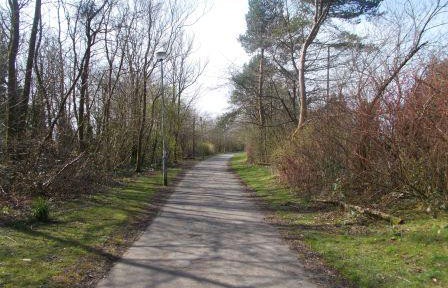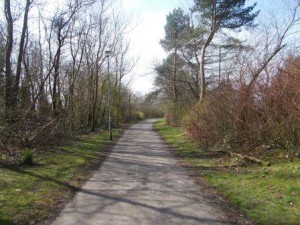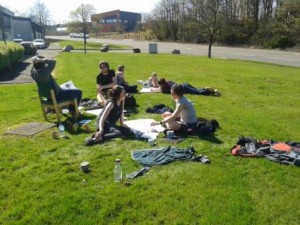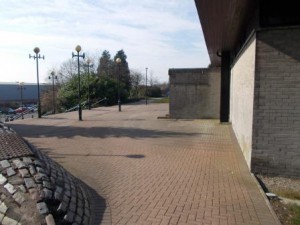
I count myself as being very lucky to be a Conservation Volunteers Natural Networks trainee. Day to day you’ll find me working in the Cumbernauld Living Landscape but I’ve got the support and expertise of TCV guiding my work too. One thing I am particularly glad to have are the other trainees. We’re spread out all over the country but in Scotland we’re placed in Edinburgh Council, Central Scotland Green Network, the James Hutton Institute, North Ayrshire Ranger service / RSPB and last but not least, the Scottish Wildlife Trust. We’ve also got two of our cousins, the Natural Talent trainees, based in the Royal Botanic Garden Edinburgh and Herriot-Watt university / SEPA. Safe to say, we cover a broad spectrum of expertise and interests! We were pleased to host the first Scottish trainees site visit in the Cumbernauld office this week, and showcased Cumbernauld in all its glory – by visiting the town centre. Maybe not what you would have expected for a bunch of environmental folk? Hear me out: the potential for increasing the strength of the green network within urban environments is perhaps one of the most exciting elements of conservation and is one of CLL’s core goals. So, how better to spend the trainees’ time by asking their opinions on the potential that Cumbernauld’s town centre offers for nature and the local community?
We took the trainees straight into the town centre and armed them with maps and a survey asking them to consider how successful they thought certain routes in and out of town were for both people and wildlife. We focussed on five elements: how attractive, accessible, safe and biodiverse the places appeared and how well they seemed to support health and wellbeing. After wandering round town with their clipboards, we brought them back to the office to have a chat about what their perceptions were. A lot of them were surprised at how green areas so close to town were, and how amazing it was to have such old and established woodlands running out of the town centre. However, there were questions raised about how connected everything was; the roads running through the centre and the paved or concreted walkways seemed to disjoint a lot of the trainee’s walks. This is something that CLL started to show with the Living Windows project and forms the backbone of my placement this year– how surprisingly natural places within Cumbernauld are and how this isn’t reflected within the town centre.
This is something we’d love to address, so the trainees were then tasked with the question: “how would you engage the local community to gain their perceptions of these routes and work toward visions for how these might be improved?” Three groups focussed on one of the elements that determine how positive a place is for people and wildlife and I’ll do my best to summarise a very fruitful set of discussions and ideas!
Biodiversity
Richard and David were discussing this topic. They thought that the areas needed to be surveyed to see what wildlife was currently in residence and suggested that this could be done in conjunction with local schools as a way of educating people. Bringing in experts from conservation charities such as Buglife, the RSPB and the Scottish Wildlife Trust might be a good way of structuring this and using their knowledge to draw up plans to improve biodiversity gives a solid foundation for future work in the area. Doing this alongside the community gives local people a good understanding of why certain things are helpful for wildlife and how to help conserve their area.
Accessibility and connectivity
Frances and Becca discussed ways of finding how local people travel and the routes they would choose to connect different places (for example, how they’d get from home to school / work, or into town). Their great idea was having guided walks around areas led by local people. This would give people a chance to share their favourite walk or even their commute. It allows the local guide to chat about whatever they think is important on that route: where people like to have a sit down and meet their friends, where they see children playing or even just handy short cuts! We talked about how this could even turn into an oral history of the routes of Cumbernauld and the changes people have seen over their lifetime, and what they’d like to see in the future.
Supporting health and wellbeing
Susan, Catherine and myself discussed how wellbeing is different to everyone and can range from mental wellbeing, to sport and fitness and many things between. As a result, there are many ways which green outdoor space can support wellbeing, so it is very important to ask people what they like and need from nature to help them stay healthy. We thought of the different ways we could chat to people about this and came up with lots of ideas. Could we offer lunchtime walks for offices to give people a break from their computer? How about trying to play different types of games with children and getting them to tell us how easy it was to run in a certain site, or if there was something interesting there to climb on? Or, how about taking photos of local places indoors and getting people to rate them as somewhere that looks like a good place to relax and recharge their batteries? Using these answers would then inform what the green route could look like and this could be used when designing them in future.
I hope I have been able to give you a flavour of the discussions that were had and the complexities that go into making a green route successful for both people and wildlife. Ultimately, all agreed that having more greenery within the town is beneficial and the potential to improve this by bridging gaps would have positive impacts for all. Part of my year this year will revolve around understanding how local people view the town centre and how best to link this into the natural reserves surrounding town. What do you think are the key elements of a green route?


